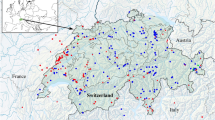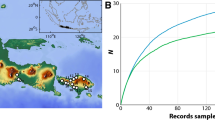Abstract
In this study, we integrated a DNA barcoding project with an ecological survey on intertidal polychaete communities and investigated the utility of CO1 gene sequence as a DNA barcode for the classification of the intertidal polychaetes. Using 16S rDNA as a complementary marker and combining morphological and ecological characterization, some of dominant and common polychaete species from Chinese coasts were assessed for their taxonomic status. We obtained 22 haplotype gene sequences of 13 taxa, including 10 CO1 sequences and 12 16S rDNA sequences. Based on intra- and inter-specific distances, we built phylogenetic trees using the neighbor-joining method. Our study suggested that the mitochondrial CO1 gene was a valid DNA barcoding marker for species identification in polychaetes, but other genes, such as 16S rDNA, could be used as a complementary genetic marker. For more accurate species identification and effective testing of species hypothesis, DNA barcoding should be incorporated with morphological, ecological, biogeographical, and phylogenetic information. The application of DNA barcoding and molecular identification in the ecological survey on the intertidal polychaete communities demonstrated the feasibility of integrating DNA taxonomy and ecology.
Similar content being viewed by others
References
Antoniadou C, Chintiroglou C. 2006. Trophic relationships of polychaetes associated with different algal growth forms. Helgol. Mar. Res., 60: 39–49.
Clarke K R, Warwick R M. 2001. Change in Marine Communities: An Approach to Statistical Analysis and Interpretation, 2nd edition. PRIMER-E, Plymouth.
Dasmahapatra K K, Mallet J. 2006. DNA barcodes: recent successes and future prospects. Heredity, 2006: 1–2.
DeSalle R, Egan M G, Siddall M. 2005. The unholy trinity: taxonomy, species delimitation and DNA barcoding. Philosophical Transactions of the Royal Society B-Biological Sciences, 360: 1 905–1 916.
Ekrem T, Willassen E, Stur E. 2007. A comprehensive DNA sequence library is essential for identification with DNA barcodes. Molecular Phylogenetics and Evolution, 43: 530–542.
Fauchald K. 1977. The polychaete worms. Definitions and keys to the orders, families and genera. Nat. Hist. Mus. LA County Sci. Ser., 28: 1–188.
Fauchald K. 2009. World Register of Polychaeta, available online at http://www.marinespecies.org.
Folmer O, Black M, Hoeh W, Lutz R, Vrijenhoek R. 1994. DNA primers for amplification of mitochondrial cytochrome c oxidase subunit I from diverse metazoan invertebrates. Mol. Mar. Biol. Biotechnol., 3: 294–299.
Hajibabaei M, Singer G A C, Hebert P D N, Hickey D A. 2007. DNA barcoding: how it complements taxonomy, molecular phylogenetics and population genetics. Trends in Genetics, 23: 167–172.
Hebert P D N, Penton E H, Burns J M, Janzen D H, Hallwachs W. 2004. Ten species in one: DNA barcoding reveals cryptic species in the neotropical skipper butterfly Astraptes fulgerator. Proceedings of the National Academy of Sciences of the United States of America, 101: 14 812–14 817.
Hebert P D N, Cywinska A, Ball S L, deWaard J R. 2003a. Biological identifications through DNA barcodes. Proc. R. Soc. Lond. B. Biol. Sci., 270: 313–321.
Hebert P D N, Ratnasingham S, deWaard J R. 2003b. Barcoding animal life: cytochrome c oxidase subunit 1 divergences among closely related species. Proc. R. Soc. Lond. B. Biol. Sci., 270(Suppl.1): S96–S99.
Kim J, Chae C. 2001. Optimized protocols for the detection of porcine circovirus DNA from formalin-fixed paraffin-embedded tissues using nested polymerase chain reaction and comparison of nested PCR with in situ hybridization. Journal of Virological Methods, 92: 105–111.
Liao X Z. 2006. Molecular Phylogenetic Analysis of Marine Sedentary Polychaeta. Master Thesis. Xiamen University, China. (in Chinese)
Liao X Z, Lin C R. 2006. Phylogenetic analysis of polychaetes based on sequences of 18S rDNA and CO1 segments. Journal of Oceanography in Taiwan Strait, 25(4): 490–497. (in Chinese)
Mikkelsen N T, Schander C, Willassen E. 2007. Local scale DNA barcoding of bivalves (Mollusca): a case study. Zoologica Scripta, 36: 455–463.
Moritz C, Cicero C. 2004. DNA barcoding: promise and pitfalls. PLoS Biology, 2(10): e279–e354.
Palumbi S R. 1996. Nucleic acids II: the polymerase chain reaction. In: Hillis D M, Moritz C, Mable B K eds. Molecular Systematics, 2nd edition. Sinauer Associates, Sunderland, Massachusetts. p. 205–247.
Purschke G, Ding Z, Mfiller M C. 2005. Ultrastructural differences as a taxonomic marker: the segmental ocelli of Polyophthalmus pictus and Polyophthalmus qingdaoensis sp. n. (Polychaeta, Opheliidae). Zoomorphology, 115: 229–241.
Ratnasingham S, Hebert P D N. 2007. BOLD: The Barcode of Life Data System (www.barcodinglife.org). Molecular Ecology Notes, 7: 355–364.
Schander C, Willassen E. 2005. What can biological barcoding do for marine biology? Marine Biology Research, 1: 79–83.
Sun R P, Yang D J. 2004. Fauna Sinica: Invertebrata Vol. 33, Annelida, Polyhaeta II. Nereidida (= Nereimorpha). Science Press, Beijing, China. 520p. (in Chinese)
Tamura K, Kumar S. 2002. Evolutionary distance estimation under heterogeneous substitution pattern among lineages. Molecular Biology and Evolution, 19: 1 727–1 736.
Tamura K, Dudley J, Nei M, Kumar S. 2007. MEGA 4: Molecular Evolutionary Genetics Analysis (MEGA) software version 4.0. Molecular Biology and Evolution, 24: 1 596–1 599.
Thompson J D, Higgins D G, Gibson T J. 1994. CLUSTAL W: improving the sensitivity of progressive multiple sequence alignment through sequence weighting, position-specific gap penalties and weight matrix choice. Nucleic Acids Res., 22: 4 673–4 680.
Will K W, Rubinoff D. 2004. Myth of the molecule: DNA barcodes for species cannot replace morphology for identification and classification. Cladistics, 20: 47–55.
Wu B L, Wu Q Q, Qiu J W, Lu H. 1997. Fauna Sinica: Phylum Annelida, Class Polychaeta, Order Phyllodocimorpha. Science Press, Beijing, China. 329p. (in Chinese)
Wu B L, Sun R P, Yang D J. 1981. Study on the Nereidae from China. Ocean Press, Beijing, China. 228p. (in Chinese)
Yang D J, Sun R P. 1988. Polychaeta Annelids from China. Agriculture Press, Beijing, China. 351p. (in Chinese)
Zhou J. 2008. Study on the Taxonomy and Faunistic Characters of Families Paraonidae and Spionidae (Annelida: Polychaeta) from China Seas. PhD Thesis. Institute of Oceanology, Chinese Academy of Sciences, Qingdao and Graduate University of Chinese Academy of Sciences, Beijing. (in Chinese)
Author information
Authors and Affiliations
Corresponding author
Additional information
Supported by the National Natural Science Foundation of China (No. 40730847 & 40906063), and the Student Research Training Program of Ocean University of China (No. 0811010509)
Rights and permissions
About this article
Cite this article
Zhou, H., Zhang, Z., Chen, H. et al. Integrating a DNA barcoding project with an ecological survey: a case study on temperate intertidal polychaete communities in Qingdao, China. Chin. J. Ocean. Limnol. 28, 899–910 (2010). https://doi.org/10.1007/s00343-010-9131-1
Received:
Accepted:
Published:
Issue Date:
DOI: https://doi.org/10.1007/s00343-010-9131-1




